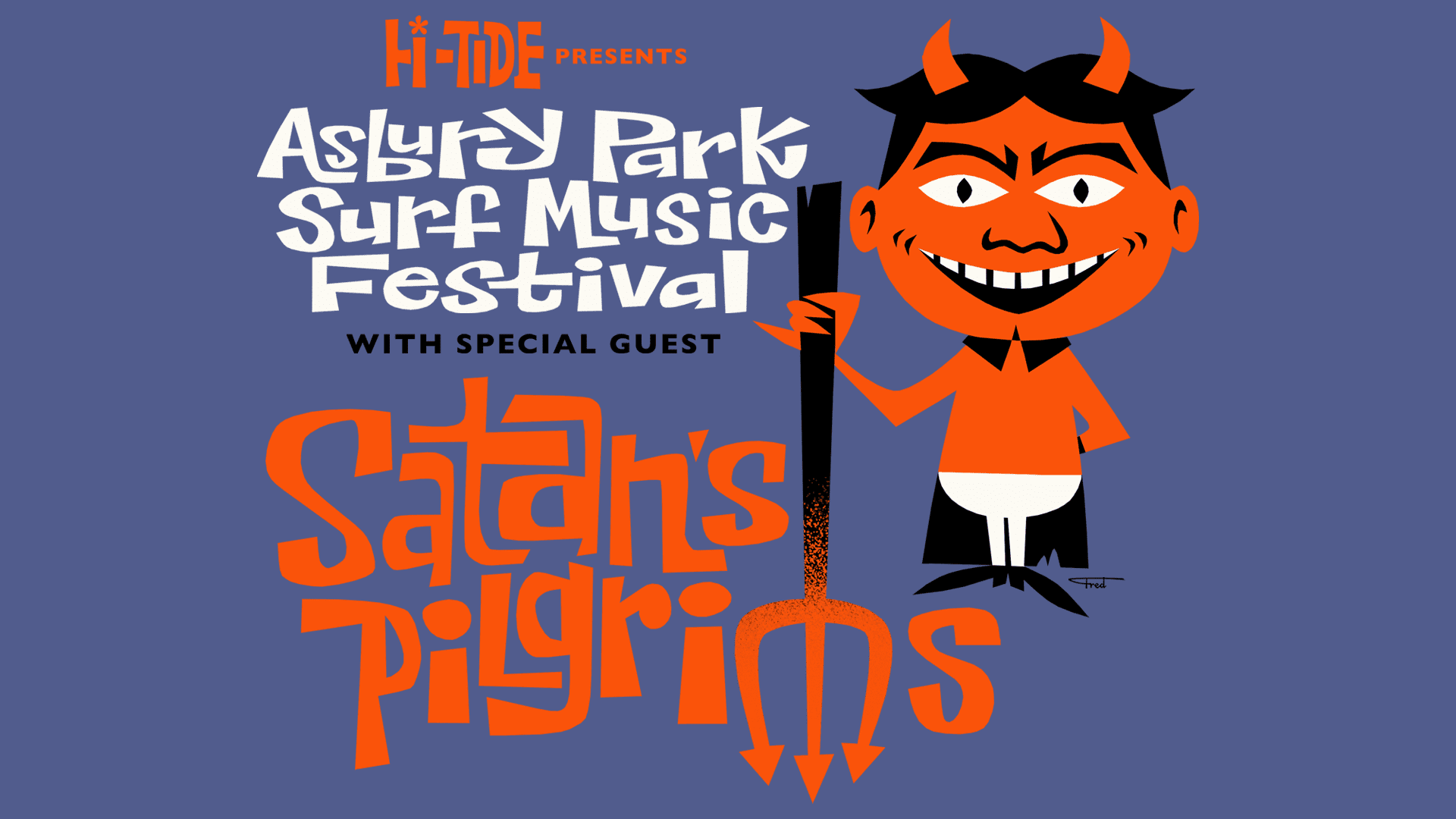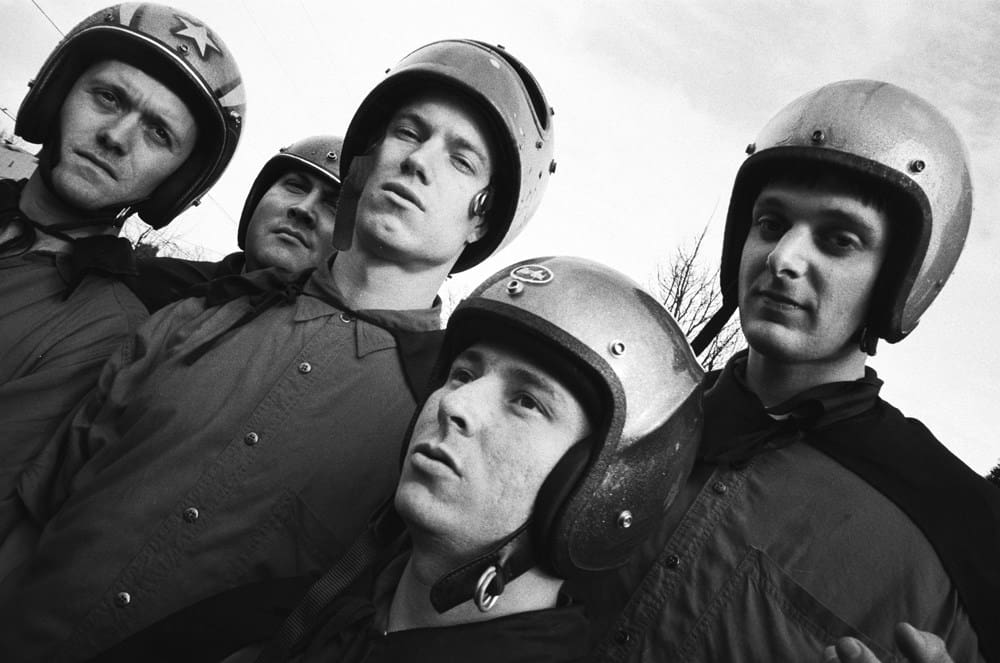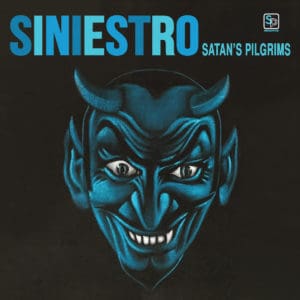Satan’s Pilgrims are a band that surf rock aficionados bow down in reverence to when they hear their name. This Pacific Northwest surf outfit melded the sounds of SoCal surf with their home region sound to create a venerated subgenre dubbed “Pilgrim Rock” which influenced bands for decades to come.
This weekend, the band returns to Asbury Park for the first time since 2006 for the annual Asbury Park Surf Music Festival. We spoke at length with Ted Pilgrim about the band’s history, and their future as they get set to perform at the this weekend.
Let’s start with the easiest, most asked question — what’s the story behind your name?
So we had been playing and practicing for a while and in the beginning, we were playing a lot of covers, as any band starting out does, and among the surf and other instrumentals, we had discovered the sub-genre of “biker film” instrumentals, many of whom were played by Davie Allan and the Arrows and featured fuzz guitars. We were digging that at the time and also watching a lot of those biker films, like Satan’s Sadists for inspiration.
We also were fans of garage and bubblegum music and Dave, one of our guitar players, was thinking it would be really funny if we had a “Pilgrim” persona, and just as the 1910 Fruitgum Company dressed up in Native American garb on one of their covers, he saw us as Pilgrims, like Thanksgiving Pilgrims, with buckle shoes and tall hats and stuff. Very goofy, which we sometimes are.
At some point, we had a show coming up and needed an official name, so we sort of combined those two things into “Satan’s Pilgrims.” We liked how it was kind of like “Hell’s Angels”, good/bad, yin/yang, but also completely tongue in cheek but we also had some of these spooky sounding surf songs, so the ‘devil” side of it was definitely cool, but like Halloween devil cool, not like satanic rituals.
We also had been learning about all of these obscure surf songs from the 60s like “Satan’s Theme,” which we covered on our first album, and “Devil Surfer” by Scott Engel. We didn’t want to have a name like “The Surf (insert word here)s,” so we thought it set us apart and got us into writing more of those spooky type surf songs. A few people can get turned off by it at first, but usually once they hear us, and definitely after they see us, they hopefully realize we are a bunch of band nerds, not into satanism or anything like that.
What do you love about surf music — a genre you’ve dedicated a large portion of your life performing?
We all played in our share of bands before playing in SP, and I think we all agree that is, for us, the most fun kind of music to play, and when people start dancing and going nuts, it gets even better! At first it might seem like it all sounds the same, but it is actually way more dimensional than a lot of other forms of rock ‘n’ roll, with influences from all over the world, it’s own guitar effect (the reverb) and it’s own musical “language.” It can go from the most beautiful sounds you’ve ever heard to just blazing ferocity and from a pin drop to a huge wall of sound all within a record or live performance. Even though there are no lyrics, we think of it as the ultimate expression of fun and life.
Can you talk about the “Pilgrim rock?” Can you describe this sub-genre of surf music that you guys helped create?
I have heard some of our fans talk about this. I think what they are getting at is that they claim that they can always tell that it’s us, whenever they hear it. I guess what set us apart was, number one, that we have three guitars and play as a band.
Pulp Fiction was released a couple of years after we started and Dick Dale’s influence was felt around the world. While we are big fans of his, his style dictates the one loud guitar guitar is way out in front being backed up by a combo, but we were more influenced by bands like The Surfaris, The Sentinals, The Bel Airs, The Astronauts, where there is real interplay between the guitars and the rhythm section. In other words, we want to present you with songs with parts rather than a display of guitar pyrotechnics.
In SP, the three guitarists take turns being the melody, or main part, but the other two come up with interesting rhythm parts or even counterpoints to go with the main guitar for that song, without it getting too busy. One of our friends put it this way the other day: “The guitarists don’t have anything to prove and are comfortable letting their rhythm section be the driving force of the band. Thus, the music is simpler and more accessible and the audience is more inclined to dance to it.”
We’ll take it!
One event that popped up in your bio was a “famous show in Slovenia.” That’s not a common phrase thrown about. Can you tell us about this show and what made it so legendary?
For us, it was legendary because we were playing in Slovenia! We were on tour in Europe in 1999 and had a show in Ljubljana, Slovenia, which had just had been visited by the legendary Portland band, Dead Moon, who they LOVED. So, I don’t know if it was because we were from Portland too, or if we were really good that night, or if the crowd was just revved up, and maybe it was a combination of all of those things, but the people went crazy all night and we got called back for encore after encore and it was just all really fun. It was also the best schnitzel of the tour!
Satan’s Pilgrims was on hiatus from 2000-2005. What brought you guys back together, and can you describe that feeling you had when you did your first concert together again?
The impetus of starting to play together again was that the record label that we had been working with when we took a break wanted to release a “Best of” compilation and asked us to record a few new songs for it. I had moved to Memphis, TN in 2000, so they flew me back to Portland to record the new songs. We had never had a falling out or anything, it just felt like the 90s surf wave was over and we weren’t pulling in crowds like we had been and it seemed like every music venue had become a dance club. Another thing that had happened during those years is that the internet had exploded and surf music fans had found each other and had been discovering us if they had missed us during the 90s.
All of a sudden, it seemed like we were bigger than we had been in the 90s and we have been doing it when we can. Even though we don’t all live together like we used to and I live more than halfway across the country, I think it has worked out better than if we had kept plugging along and were still trying to play all the time. We got a new appreciation for it, plus it kind of keeps us on our toes and it stays exciting. We definitely are not “phoning it in” because it is one of 250 shows we will play in a year. We only play a few times a year, so it is special for our fans and for us too.
I can’t really describe the feeling of that first show. It was in Portland, and it was a room full of what felt like all of our old friends, plus a bunch of new fans had flown in from all over the country. It really blew our minds.
Let’s talk about your last record Siniestro. This was a self-funded, self-produced record. Can you talk about the feeling of producing and recording your own record as opposed to being on a label. Is there more or less pressure? Was it a more creatively adventurous process for you?
Siniestro is actually the third release on our own SP Records. The first one was Psychsploitation that we released in 2009 and then Frankenstomp in 2015. Frankenstomp was a compilation of singles and unreleased stuff and Psychsploitation was recorded by Eric Hedford, who had been in The Dandy Warhols. Even though he engineered and helped produce it, we put it out ourselves.
But back to Siniestro, yes, this was the first one where we did everything from beginning to end. We wrote the songs long distance, emailing them back and forth. The summer before we recorded, we rented a beach house in Manzanita, OR together with most of our families, clamming and going to the beach during the day and then cooking and hashing out the songs at night.
After over 20 years of making records, we wanted to give it a try on our own, without some goofy engineer looking through the glass at us, waiting for us to be ready. We asked around Portland that fall, and one of our oldest friends was able to hook us up with a boarded up Masonic Lodge that the company he worked for had just bought. It had a big ballroom, was all wood, had a great natural echo, and when it rained, water poured through a big whole in the ceiling. It was perfect!
We holed ourselves up in there for about a week, ate tacos from the same taqueria around the corner for every meal and knocked out the album. For us, I think it was less pressure, we knew it was going to work, and it was costing us next to nothing. It was definitely a more creatively adventurous process for us, especially in terms of finding the sound that we were after.
You’ll be performing at the Asbury Park Surf Music Festival this year. Outside of performing your set, what are you most excited for with this show? A band you’re stoked to see?
Let’s see, of course there is seeing a lot of our friends from many of the bands, and I’m interested in seeing what has happened with Asbury Park. The last time we played there in 2006, it was pretty deserted. It was in March, which didn’t help, but I think there has been a lot of rejuvenation etc that will be interesting to check out. We also have lots of fans from the East Coast that we haven’t seen since the late ’90s, that will probably be the most exciting thing. I’m going to wimp out and say I’m excited to see all of the bands play, but I’m just a little more excited to see the bands that I have never been able to see before (which is most of them, surprisingly).
If I had to pick one, I would say Les Agamemnonz from France. They e-mailed me last year about setting up gigs on the West Coast as part of their tour, and I suggested that they try and get on board with Asbury Park Surf Music Festival on their way back home, and it worked out! They have been touring the West Coast already and everyone has been raving about their shows out there. And they wear togas.
What’s your favorite tropical drink?
Mezcal with an orange peel twist.
Finally, what is the greatest surf movie of all-time?
Beach Girls and The Monster! It’s totally drive-in black and white B-movie, has a guy in a seaweed covered monster suit, great surfing footage (lifted from an actual surfing film), and best of all, real surf music, played by members of a real 60s surf band, the Hustlers. They play surfy stuff for the incidental music and play the theme song, both instrumental and vocal, with guest vocalist, Frank Sinatra Jr.!




